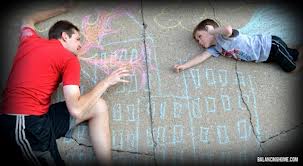Boy play is noisy, boisterous, physical, aggressive, and spontaneous in nature. Dads** understand this play and may intuitively provide these outlets for their rough-and-tumble kids. Research (Lamb, 2000) shows that moms are associated with food, comfort, security, and love, while dads are associated with fun, excitement, and play. Children need exposure to both types of adult interactions. However, most preschool environments favor women’s interaction styles, verbal and literacy activities, and socio-dramatic play.
At around 3 ½ years old, most boys begin to gravitate towards superhero play. They explore power in multiple ways: externally (I can fly like Superman, I am super strong like Batman) and within social relationships (good guy/bad guy scenarios). This morality play between “good” guys and the “bad” guys is certainly not a new phenomenon. Cops and robbers, cowboys and Indians, and war play are all an integral part of typical boy development. The challenge for parents and teachers is when these games include gun play. Many boys love “shooting” games. They build shooters out of Legos, blocks, pencils, or with their fingers. It’s very difficult, if not impossible, to eliminate this type of play, even with all the “no gun play” rules at home or in preschool.
Life and death are still very abstract concepts for preschoolers. As boys grapple with the role of “good guy” and “bad guy,” gun play allows for a sense of power and control within that play. One strategy is to extend the play by adding multi-player rescue or hero themes. If two boys are shooting each other, direct them to shoot water out of the “fire hose” to save the house or building. If the “bad guys” are going to jail, encourage them to come up with ways to get out of jail or repair the “bad” behavior. If there are two boys playing firefighter, add a third child who can be the ambulance driver or doctor/nurse at the hospital.
(bad guy) (good guy)
Here are five ways to support the active play of young boys:
1) Provide space and time for big, outdoor physical activity.
2) Boys need more space! Let them spread out on the floor.
3) Provide outdoor projects, building, gardening, and outdoor games.
4) Provide hands-on learning rather than verbal instruction.
5) Create safe indoor spaces for rough-and-tumble play (gym mats, Nerf balls).
Boys bring spontaneous, wild fun into any environment. As parents and teachers, we need to find ways to respect and honor boys’ play ideas and contributions so that we can support them as they build social skills, increase their self-confidence, and become active contributors to their own learning.
*I use the conventional term “boys” to describe high-energy, rough-and-tumble play, but there are girls who may also share these qualities.
**I use the conventional term “dads” to describe more physical, exciting play, but there are moms who may also play this way with their children.
Additional Reading:
The War Play Dilemma, by Diane Levin and Nancy Carlsson-Paige




